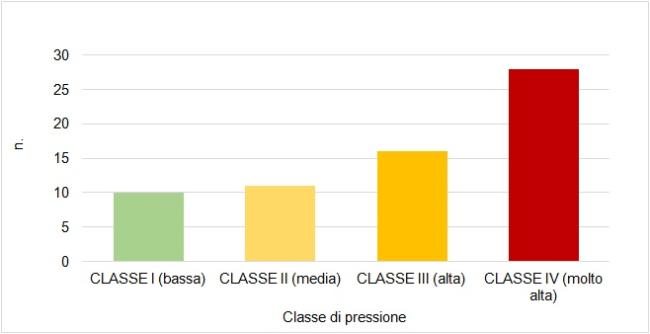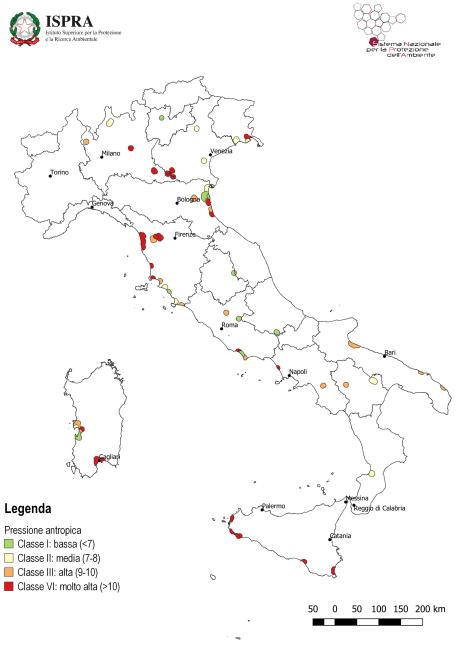Panel 1
DE FIORAVANTE Paolo (Università della Tuscia), GIULIANI Chiara, MARIANI Lorella (IUSS Pavia), MUNAFO’ Michele (ISPRA)
A significant portion of Italy’s Ramsar sites is subject to anthropogenic pressure due to both the presence of settlements and infrastructure and agricultural activities. In 45 out of 65 cases, agricultural areas occupy more than half of the Ramsar site's territory. While urbanized areas and infrastructure have a smaller spatial extent, they still contribute to the pressure affecting Ramsar sites. Approximately one-quarter of these areas experience high or very high levels of urbanization pressure. A total of 68% of wetlands fall within Class III (high pressure) and Class IV (very high pressure), highlighting the fragile balance in which these environments exist. Only 15% of the areas fall into Class I (low pressure), while 17% belong to Class II (moderate pressure).
The indicator measures the levels of anthropogenic pressure within each Ramsar area and within a 5-kilometer buffer zone surrounding its perimeter. To define pressure levels, significant potential sources of impact on conservation status have been considered, including land-use intensity, fragmentation, and land sealing. Two partial indices have been developed: one related to artificial land cover and the other to agricultural activity. The calculated data has been categorized into five intensity classes. The anthropogenic pressure index is the sum of these two partial indices and is assigned to one of the following classes:
Class I: Low anthropogenic pressure (values below 7)
Class II: Moderate anthropogenic pressure (values between 7 and 8)
Class III: High anthropogenic pressure (values between 9 and 10)
Class IV: Very high anthropogenic pressure (values above 10)
To assess the extent of pressures that may interfere with the conservation status of wetlands of international importance.
Ramsar Convention on Wetlands (1971), ratified in Italy by Presidential Decree No. 448 of 13/03/1976 and Presidential Decree No. 184 of 11/02/1987 (implementation of the amendment protocol to the Convention).
Paris Convention (1950), ratified in Italy by Law No. 812/78.
Legislative Decree No. 152/99 (Framework Law on Water).
The Ramsar Convention is a treaty aimed at conserving wetlands and their resources. Its primary goal is to curb wetland destruction, particularly in areas vital to migratory birds, and to officially recognize their high ecological, scientific, cultural, and economic value. The Convention focuses on three main actions:
Identifying wetlands of international importance
Promoting the sustainable use of wetlands
Encouraging international cooperation
Panel 2
-
This indicator is functional in describing the phenomenon investigated within wetlands of international importance, but does not provide any insight into the overall situation of wetlands at the national level.
-
Data quality assessment
ISPRA (Superior Institute for Environmental Protection and Research)
MATTM (Ministry of the Environment and Protection of Land and Sea)
SNPA (National System for Environmental Protection)
http://www.sinanet.isprambiente.it/it/sia-ispra/download-mais/corine-land-cover/
http://www.minambiente.it/pagina/zone-umide-di-importanza-internazionale-ai-sensi-della-convenzione-di-ramsar
https://www.tomtom.com/it_it/
National, Regional (20/20)
2012, 2018
Indicator assessment
The anthropogenic pressure index is derived from the sum of two partial indices related to artificial land cover and agricultural activity. These indices are calculated using Copernicus CORINE Land Cover data and the National Soil Consumption Map for 2012 and 2018. The artificial land cover index is based on urbanized areas, while the agricultural activity index is based on farmland coverage. The analysis includes both Ramsar sites and a 5-kilometer buffer zone. The final composite index is classified into four pressure levels (low, moderate, high, very high).
Significant anthropogenic pressures persist due to both settlements and agriculture. Wetlands are often located in lowland areas with abundant water resources, making them attractive for agriculture. As a result, agricultural areas cover more than half of the Ramsar site in 45 out of 65 cases.
Urbanized areas and infrastructure, though smaller in extent, still exert a notable impact. Approximately 25% of Ramsar sites experience high or very high urbanization pressure.
Compared to previous reports, recalculations based on updated 2012 and 2018 data reveal a general stabilization of anthropogenic pressure on Ramsar sites. However, significant anthropogenic pressures persist due to both settlements and agriculture. Wetlands are often located in lowland areas with abundant water resources, making them attractive for agriculture.
Data
Tabella 1: Indice e classe di pressione antropica sulle aree Ramsar (2018)
Elaborazione ISPRA su dati del Ministero dell'ambiente e della tutela del territorio e del mare (2017), CORINE Land Cover 2018, Carta Nazionale del Consumo di Suolo 2018
| Pressione da urbanizzazione | ||
| Classe | Entità | Indice |
| <5 | molto bassa | 2 |
| 5-10 | bassa | 4 |
| 10-20 | media | 6 |
| 20-25 | alta | 8 |
| >25 | molto alta | 10 |
| Pressione da attività agricola | ||
| Classe | Entità | Indice |
| <10 | molto bassa | 1 |
| 10-30 | bassa | 2 |
| 30-50 | media | 3 |
| 50-70 | alta | 4 |
| >70 | molto alta | 5 |
| Classi di pressione antropica | ||
| Classe | Entità | |
| I | bassa (ind. press. antropica <7) | |
| II | media (ind. press. antropica 7-8) | |
| III | alta (ind. press. antropica 9-10) | |
| IV | molto alta (ind. press. antropica>10) |



The analysis of urbanization and agricultural activity indices for 2018 highlights the strong presence of agricultural environments and, to a lesser extent, urbanized areas within Ramsar sites and their buffer zones. It was found that 35% of the areas considered (23 out of 65) have agricultural land covering more than 70% of their surface; these areas have the highest value (5, very high) for the agricultural activity pressure index (Table 1). If the threshold is lowered to include areas where agricultural land covers more than 50% of the total surface, the number of affected Ramsar sites increases to 45 (70% of the total). The most impacted area is Punte Alberete in Emilia-Romagna, where agricultural land covers over 94.4% of the examined territory.
Urbanized areas are present to a lesser extent. In fact, the majority of the areas (27 out of 65, equal to 41% of the total) have infrastructure and urban coverage below 10%. However, some significant exceptions are found in wetlands near urban centers: in Sardinia, at Stagno di Molentargius, urbanized surface reaches 53.6% (urbanization index of 12), while in Sicily, the Ramsar sites of Saline di Trapani (30.6%) and Palude di Capo Feto (38.8%) have an urbanization index of 10 (very high).
Overall, concerning the anthropogenic pressure index, only 15% of the Ramsar sites experience low anthropogenic pressure (10 areas in Class I), while 17% show medium levels of pressure (11 areas in Class II) (Figure 1). A total of 68% of wetlands fall within Class III (high pressure) and Class IV (very high pressure), with 16 areas in Class III and 28 in Class IV (Table 1; Figure 1). This highlights the fragile balance of these highly sensitive environments, which, due to their internal dynamics, are constantly threatened by surrounding human activities.
At the regional level, the highest values are recorded in Sicily, where all six Ramsar sites experience the maximum level of anthropogenic pressure (Class IV) (Figure 2). A high level of anthropogenic pressure (Class III) is also observed in the Ramsar sites of Puglia and Campania, as well as in approximately half of the areas located in Tuscany and Emilia-Romagna (Figure 2).
The lowest pressure conditions are found in the areas of Lake Tovel in Trentino-Alto Adige and Lake Barrea in Abruzzo, where the pressure index is 3 (Class I, low pressure).
Regarding the evolution of territorial dynamics within the 65 Ramsar sites and their respective buffer zones, from 2012 to 2018, the supplementary analysis in Figure 3 highlights a general increase in land occupied by urbanization and infrastructure, particularly in Sardinia (101.5 hectares), Tuscany (92.94 hectares), and Emilia-Romagna (84.7 hectares). In contrast, this phenomenon is almost absent in Trentino-Alto Adige and Abruzzo. Additionally, a reduction in agricultural areas is particularly evident in Tuscany (-130 hectares), as well as in Sardinia and Emilia-Romagna.
Overall, there has been an increase in urbanized areas by 602.93 hectares and a decrease in agricultural land by 648.53 hectares.